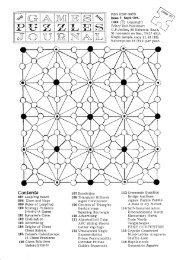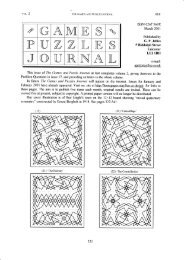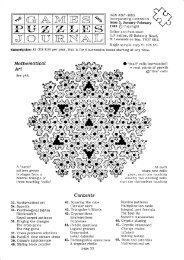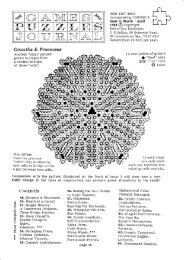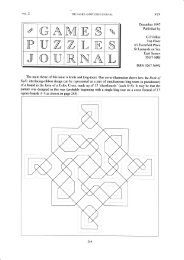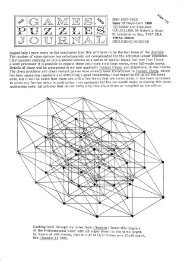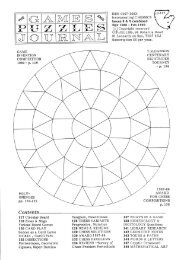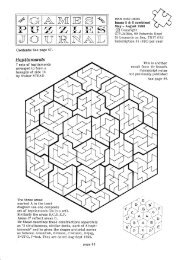Chessics, #28 - Mayhematics
Chessics, #28 - Mayhematics
Chessics, #28 - Mayhematics
You also want an ePaper? Increase the reach of your titles
YUMPU automatically turns print PDFs into web optimized ePapers that Google loves.
C I{ E S S I C S<br />
THE JOURNAL OF GENERALISED Ci-IESS<br />
specicl rs.sue on chessoo ard Dis.secttons<br />
The first ever assembly of the 108 pieces of ? squares. Done by lValter Stead<br />
on 5th June 1955, but not previously published, as far as I know. The pieces cover<br />
a square of side 28 units, leaving a eentral pattern of 28 uncovered squares.<br />
IssN 0142-7342. euarterly. votume 2. Nffi<br />
Price 50p per issue (f 2 per year). Giro account number 4g-1?1-g200.<br />
G-P-Jelliss, 99 Bohemia Road, st{,eonardson-sea. TN3? 6RJ, England.<br />
page 137
CHESSICS 28<br />
Special Issue on Chessboard Dissections<br />
By G.P.JELLISS<br />
Aclmowledgement<br />
I am most grateful to Philip J.Stead for allowing me to borrow and photocopy<br />
three manuscript booklets of 'rProblems and Puzzlestrby his father, Walter<br />
Stead, who published and edited ?'Dissectionttitems in the Fairy Chess Review<br />
from February 1953 to February 1957. These booklets include several results<br />
that have not previously been published, as far as I have been able to ascertain.<br />
History<br />
Notes on Dissection Problems have previously appeared in <strong>Chessics</strong> issues<br />
3, 6, 10 and 23. The term (pgly)"rirrg for any piece composed ofGqGres ;oined<br />
edge-to-edge was coined by S.W.Golomb in his Harvard lecture of 1953 (on the<br />
assumption that a domino is a di-omino). The first recorded puzzle using att the<br />
12 different 5-square pieces is No 74 in The Canterbury Puzzles and Other Cur:<br />
ious Problems by H.E.Dudeney, published in 1907. However, the maln Cevelop:-<br />
ment of the subject, using all the pieces from 1 to 6 squares, was in the pages<br />
of The Problemist Fairy Chess Supplement/Fairy Chess Review during the years<br />
19 .Lest6r, H.D.<br />
Benjamin, F.Hansson, W.Stead and others (some of whose names appear later in<br />
the issue). The first book on the subject was S.W.Golomb?s Polyominoes (196b). A<br />
bibliography covering more reeent work, compiled uy w.l,.schLaaf,aplears in the<br />
Journal of Reereational Mathematics_, Vol 16(No 4), 1983-4 (broughtio my notice<br />
No 6, Sept 1gg6 has a nine-page<br />
specialsupp1ementonHexo@aswewenttopress.<br />
Dominoes<br />
How many ways are there of dissecting a board m by n (m<br />
I n) into dominoes?<br />
The following formulae summarise my results on this problem so far:<br />
d(m,n) = [ e(m,s)d(m,n-s) (summed over s = 1 to n)<br />
e(m,n) = [ f(r,n)e(m-r,n) (summed over r = 1 to m)<br />
where d(m,n) is the total number of dissections, e(m,n) is the number without vertical<br />
"fault linest'and f(m,n) the number without vertical or horizontal fault lines,<br />
and d(m,0) and e(0,n) are taken equal to 1.<br />
When m=2 these general results reduce to the well-known Fibonacci relation:<br />
d(2,n) = d(2,n-1) + d(2,n-2)rsince e(1,2) = e(2,2) = 1 and e(2,n) = 0 for n ) 2. This<br />
resultdatesbackatleasttoW.L.PattonAmericanMat@1961(as<br />
cited in Golomb's 1966 book, Polyominoe<br />
The above recurrence relations enable one to calculate e(mrn) and d(mrn) if<br />
one knows f(r,s) for all values of (r,s) up to (m,n). For most small values f(r,s) is 0.<br />
The non-zero values that I have found so far are:<br />
f.(I,2) = 1, f(5,6) = 6, f(5,8) = 116, f(6,7) = L24t f(0,8) = e Z<br />
(though these could do with an independent check). Tne other non-zero cases that<br />
require enumeration arei (r,s) = (2,8), (8,8), (6,9), (8,9), (5,10), (6,10;, (?,10), and so<br />
on. Perhaps someone with a computer could get to work on this?<br />
page 1 38
CHESSICS 28<br />
Another result on dominoes I have found is the following: (a) Every domino<br />
dissection of a rectangle must contain at least one 2x2 inset (i.e. two dominoes<br />
side by side). (b) A domino dissection that has exactly one 2x2 inset must be either<br />
square (2kx2k) or near-square (2kx2k-1), with the 2x2 centrally placed and the<br />
other dominoes in I'rings?'around it.<br />
To prove (a) start at the aL corner and try to construct a dissection without<br />
a 2x2. We are forced to place dominoes in a rtherringbonefr pattern diagonally from<br />
the corner, and this forces the formation of a 2x2 where it meets the 6pposite edge.<br />
The geometrically unique solution to (b) for the 8x8 board is diagram.ed uetow tii<br />
solves the trComic Cutst?problem 1S0 given in <strong>Chessics</strong> 231.<br />
Problem 151(a) of removing as few squariffiEtches) as possible to leave<br />
a pattern with no squares is solved by the very similar diagram alongside, in which<br />
33 matches (of the L44) are removed. A connection between the twipuzzles is an<br />
unexpeeted surprise. [The case of 40 matches in a 4x4 array is given by K.Fujimura<br />
in The Tokyo Puzzles (UX eCition, 19?9, problem ?).J<br />
150 L5L(a)<br />
151(b)<br />
One 2x2 inset No squares<br />
The only solution Remove 33 sicles<br />
No Rectangles<br />
Remove 43 sicles<br />
Trominoes<br />
The solution to problem 151 (O) of removing as few matches as possible to<br />
leave a pattern with no rectangles is solved by the third diagram above, which is<br />
related to a dissection of the plane into trominoes. The pattern of four L-shaped<br />
trominoes on which this is based solves the hoary old problem of dissecting an l,-<br />
shaped field into four congruent parts.<br />
Tetrominoes<br />
Some tetromino results were given in <strong>Chessics</strong> issues 3 and 6. Very little<br />
work has been done. on them. I give here lust onGult, eomecting a minor error<br />
in FCR April 1937 (solution to problem 2623) where B.Larsson states that there<br />
are 117 ways of dissecting a 4x4 board into 4 pieces each of 4 squares and that<br />
there are 21 fundamental forms. The 11? total is correct, but there ate 22 forms,<br />
as diagrammed here (the number below each gives its number of orientations):<br />
page 1 39
CHESSICS 28<br />
Pentominoes<br />
The best-known puzzle with the 12 differently shaped 5-square pieces is to<br />
cover a chessboard with them, leaving the four uncovered squares in various, prespecified<br />
positions. Some examples follow. The first three, by T.R.Dawson (FCR<br />
April 1937) show that the four squares can be left in 2x2 formation anywher6lthe<br />
board (10 geometrically distinct positions). The L-shaped piece bordering two<br />
sides of the 2x2 ean be rotated within the 3xB area it occupies to provide other<br />
positions for the 2x2. Computer analysis by D.S.Scott in 1958 (reported in Golombrs<br />
book) counted 65 geometrically different solutions with the 2x2 space in the centre.<br />
The other diagram shows a 2x2 space with all the 5-square pieces abutting edges of<br />
the board. This is also by Dawson (IgE June/August 1938). Similar proofs were<br />
given by Dawson for the T-shaped tetromino (20 positions, FCR Feb/April 1943)<br />
and the L-shaped tetromino (41 positions, FCR April/June 1943).<br />
T.R.D.<br />
T.R.D.<br />
T.R.D.<br />
The next 16 diagrams show other ways in which the four uncovered squares<br />
rnay form a square. The first 9 show all the centro-symmetric cases. The first is<br />
by W.E.Lester (FCR Aug/Oct 1935) the next two by P.B.van Dalfsen (IqR June/<br />
Oct 1953) and ttre Tourth by W.Stead (f'Cn Dec 1954). The others are IioE Pentominoes<br />
(1981) by S.Farhi. There then-Tdliow 6 eases illustrating all the poffil6<br />
positions of the cross-shaped piece within a 3x3 space. The first of these is due<br />
W.E.L. P.B.vD. P.B.vD.<br />
page 140
gHESSICS 28<br />
to F.Hansson and D.H.Hersom, independently (FCR J"nE/eug 1939). The second<br />
was proposed by W.Stead as problem 1063? in FtR Oct 1956. Due to discontinuation<br />
of tne column, no solution was published, but it appears in the manuscript<br />
books mentioned in the Acknowledgement to this issue of <strong>Chessics</strong>. The other<br />
four solutions are my own work (GIP.J.). Finallv another exampteTrom Stead's<br />
manuscripts. Readers may like to try other non-centro-symmetric placements<br />
of the four squares - how many cases are there?<br />
,/<br />
G.P.J.<br />
G.P.J.<br />
G.P.J.<br />
The first of the diagrams below, showing the four spaces in a diagonal line,<br />
is by D.H.Hersom G9& Dec 1937/Feb 1938) and the next two by W.Stead (_FCR.<br />
Dec 1954). The othFFive diagrams, completing the set, are my own work.<br />
Many more fancilful shapes are of course possible with the pentominoes,<br />
numerous examples are given in the booklet by Farhi. Readers may like to try<br />
their hand at finding new results for publication in <strong>Chessics</strong>, since it is intended<br />
to maintain itDissection Problems?'as a regular section from now on.<br />
D.H.H.<br />
G.P.J.<br />
G.P.3.<br />
page L4L
CHESSICS 28<br />
The L2 pieces can also be arranged to form rectangles of 60 squares of any<br />
of the shapes 3x20r 4x15, 5x12r Gx10. The earliest solutions to these are shown.<br />
That there are only two eases 3x20 was shown by F.Hansson (PFCS Jun/AuS 1935),<br />
a result confirmed by D.S.Scott using a computer in 1-958. The other examples are<br />
all due to W.E.Lester (PFCS Feb/April 1935) in all every piece abuts an edge. There<br />
are, according to Prof C.B.Haselgrove,2339 solutions to the 6xL0 problem.<br />
F' . rI.<br />
F'or second solutiortr rotate the middle section<br />
w.E.L.<br />
W.E.L.<br />
fire FCR Notation<br />
The dissection problems in Fairy Chess Reviery were not, except on two<br />
occasions,shownindiagramform@makingblocksforprinting<br />
by the letterpress meth-od then in use) instead a coding method was used. The 56<br />
of sizes 1 to 6 were numbered, each in a standard orientation. Alternative<br />
"hapu, orientations of a piece were then indicated by a letter. for example the L-shaped<br />
tetromino in its various orientations lvas coded as follows:<br />
6A 6B 6C 61) 6E 6F 6G<br />
Any dissection could then be notated by naming the pieces and their orientations<br />
in sequence from top left of the diagram row by row. The method is ingenious' but<br />
misprints or errors in coding make it difficult to reconstruet some of the solutions.<br />
However, I have now decoded most of the results in FCR and some are published<br />
in this issue in diagram form for the first time. Where referenees to FCR give two<br />
dates the first refers to the statement of the problem, the second tolTF-solution.<br />
THE PVZZLE BOX<br />
A well-made wooden set of 12 plane "pentacubes" is manufaetured<br />
by the Pentangle company. I can supply a set at t3.75 plus tl.25<br />
post and packing. Allow 28 days for delivery. Also available is the<br />
booklet Pentominoes by Sivy Farhi (t1.57) and a range of wooden<br />
trrree-oifrffiTpuzzles by Pentangle - further details on request.<br />
page L42
Iue<br />
CHESSICS 28<br />
t 2 3+ 5 6 7 I I lot(t2' t3 t+ ts t6 t7 ,8 t9 2o 2l<br />
E, r [tr ilrFnh IrFFEht=bTr?TL+<br />
22 23 Z+ AU 26 27 28 2s 3a 3t 32 33 34 35 36 37 38 39 4o +t st 52 s3 -s* 55 ts6<br />
The listing of the 7-square pieces shown below is a (reduced) tracing of a blueprint<br />
among W.Stead's papers. (He was a professional draughtsman). The listing<br />
of the 1 to 6-square pieces I have drawn in a similar style. For some reason (or<br />
none) Hansson & Stead have the pieces aligned at the base whereas Dawson &<br />
Lester align them at the head. D&L wrote: "It may be noted that the numbering<br />
and orientation has been done on systematic lines as follows. The pieces are<br />
ranged in increasing size. Where they are of the same size the number of files<br />
increases from left to right, while squares on second and later files move successively<br />
lower.'? Hansson?s listing follows the same rules. These rules, howevert<br />
are not sufficient to fix the list exactly, and I am not clear whether additional<br />
unstated rules are in operation or whether there is an element of chance.<br />
T!-tg S r-veN So-uARE Frr c FS<br />
fl --<br />
n ,r-,,.,. fl -.TL. [l n rur=F--n<br />
il t T<br />
----<br />
Lr T FFEF FtI F EEtHhLh !I F] F tF F r r F<br />
57 59 59 60 6t 62- 6" 64 6t 66 67 6g 69 70 7t .72<br />
73 74 15 '76 77 7A 79 8a 8l<br />
ru rr-a rt- fJ 11 t;r rq rL-- [l r_-1- F [J F rq [\ |-'- [- f- I'<br />
tHt r,trrt--1 t-1 ll-ul=lFllLrl /l ll\ lLrl\ lrrr Lr I r-J\r-r-l<br />
U H lJ \-/\JU<br />
U U'-LlLl LJ\l \i'L:11 lJ'Ll U [-l, L5<br />
8Z A7 g4 85 A6 a7 8A 89 9o el' 9z 9> 94 9s 96 97 9a 99 rao lor<br />
b b L m tr trqrhH Lrrhm h h T + + t t ?<br />
loz loA ro4 lo5, lo6 la7 lo8 .c9 llo llt l12 l13 ll+ tl5 ttG \t7 l18 tt9 tk lzl<br />
n- fL ra -a-<br />
11 \1 T tr + tT s ff #t q ry h r \ T T t T<br />
lZ2- 127 t24 125 12-6 127 123 129 l3o l3t l3z \33 17+ l.35 136 tV7 t3a 139 t4-a l'+l<br />
t t + + # r= tr h L h qL rn t- b h h'Iil<br />
t+2 t47 t44 l4s t4.9 t4V t+8 149 I5o 152- t53 t5+ t55 l5 6 ts7 lsa<br />
hhqLf fr+<br />
A rN l9.ta<br />
f 59 L6a t 6l 162 t63<br />
page L43<br />
BY<br />
w9.1955
CHESSICS 2S<br />
Hexominoes<br />
The 6-square pieces (hexominoes) were first enumerated by H.D.Benjamin in<br />
Problemist Fairy Chess Supplement, December 1934. There are 3b of them in all,<br />
It is impossibie to use the 35 hexominoes to cover any rectangle. This was<br />
first proved by Dr F.Kadner elqq February 1935). The reason is that, if the pieces<br />
are placed on a chequered boffi-Tfren24 of lnem will each cover 3 black and 3 white<br />
squares' but 11 of them will cover 2 of one colour and 4 of the other. It follows that<br />
any chequered area covered by the 35 pieces must show a colour difference (i.e. an<br />
excess of squares of one colour over squares of the other cotoui) oT z,ololT4rlg or 22.<br />
F.H. cd = 2<br />
The diagrams show some of the shapes<br />
that have been devised that make use of<br />
all 35 of the hexominoes, one example<br />
for each colour difference.<br />
The triangle with serrated hypotenuse<br />
was given by H.D.Benjamin in FCR<br />
Feb/April 193? (problem 2622), and the<br />
square with central 3x5 hole is due to<br />
F. Hansson, F CR F eb/Oct 1 95 0 (prob.<br />
8558). The other four examples are new.<br />
Another well-known arrangement with cd<br />
L4 is as a parallelogram with sloping edges<br />
serrated. Golomb is unable to name its discover€rr<br />
but it appears in Mr Steadls notes<br />
with the initials W.S. alongside, and it was<br />
first published in his article in FCR Dec s4"<br />
I[.D.B. cd = t0<br />
page L44
CHESSICS 28<br />
l\l-<br />
\\\N\}\<br />
-r\r s\k<br />
t\r<br />
ls<br />
-1 hv<br />
t,, rt<br />
b'<br />
a.'<br />
c)<br />
A^11 of the examples except the cross-with-7-holei atso-satisfy the extra condition<br />
of havingrtno cross roads'f (NCR), i.e. nowhere do four edges meet to form & ,,plusrr<br />
sign' Most hexomino dissections can be achieved under this extra eonstraint, and<br />
it is.generally held to add to the artistic attractiveness of the pattern, as wett as<br />
testing the ingenuity and patience of the constructor just a litile more.<br />
The t'pyramid" (more precisely, triangle with serrated right-angled edges) has the<br />
added feature that the 2x3 '?block[ ean fall down (when rLleaset by py"ramid robbers<br />
entering the middle chamber!) so that the 3x5 hole is in an altern"iiu" position.<br />
The pages of FCR offer no guidance to would-be construetors as to any systematic<br />
yay of solvinflffih abstraci- jig-saw puzzles as these. The only hint that i can offer<br />
is that it seems to help if the Jrclumps" (pieces incorporating a 2x2 parl) are as far<br />
as possible reserved for later insertion,. particulartylne three asymmetric clumps,<br />
but I cannot offer any sound reasoning to show wtry tnis should ue so.<br />
page L45
CHESSICS 28<br />
Mixed Polyominoes<br />
One of the fascinating aspects of polyominoes is the curious mixture that<br />
they provide of arithmetic and geometry. To cover an area of N squares we must<br />
select an appropriate set of pieces, and preferably the choice should not be arbitrary,<br />
nor the result of too many conditions. The following examples combine sets<br />
of all ominoes of two or more different sizes.<br />
The pieces of sizes 213 and 4 will cover a 4x7 rectangle, as Dorothy Dawson<br />
(daughter of T.R.) showed (PFCS peb/Apr 1936) with every piece abutting an edge.<br />
The 4 and 5-square pieces will cover a rectangle 8x10. The example by BenJamin<br />
(FCR peb/Apr 1943) divides into four equal corners and central 2x2. By adding a<br />
1@are piece (monomino), or allowing a single ho1e, we can cover a 9x9 square.<br />
The example by F.Hansson (FCR Feb/June 1955) shows that instead of avoiding<br />
crossroads we can deliberately include them as part of the pattern.<br />
ffi<br />
I_TLJ<br />
F--L--l<br />
b.n.D.<br />
FI.D.B. F" H.<br />
Finally two hexomino mixtures by H.D.Benjamin. With the two trominoes he<br />
forms a 15x15 minus 3x3 (FCR Aug/Oct Lg47). With the pentominoes he forms a<br />
rectangle 15x18, or alternatively a stepped parallelogram by moving the wedge of<br />
5-square pieces to the right hand side.<br />
FI.D.B.<br />
Readers are invited to attempt disseetions that show various number theory<br />
results. For example, that 36 is both a square (6x6) and triangular (7+2+3+4+5+6+7<br />
+8) number, or that 5x5 = 4x4 + 3x3 (i.e. a 3-4-5 triangle is right angled). There<br />
must be many more possibilities. Suggestions for solving would also be welcome.<br />
page 146
CHESSICS 28<br />
Heptominoes<br />
The sizes 1 to 6 probably provide enough possibilities to satisfy most people's<br />
interest in polyominoes, but for the real fanatic the next step must be to make for<br />
himself a set of the 108 ?-square pieces t!gp!".ir""r). These were first counted<br />
by F.Douglas and W.E.Lester in Fairy Chess Review April !937, but the first actual<br />
assembly of them into a pattern was apparently not done until nearly twenty years<br />
Iater by W.Stead, as shown on the front cover. The back cover shows another<br />
remarkable arrangement, due to David Bird. In the diagram below, my favourite,<br />
Stead has solved the problem of fitting the heptominoes into a 21x37 = ???-square<br />
rectangle with 21 gaps (5 at each corner and 1 in the centre). It bears the date of<br />
26th August 1973 and the title "The Square Spirail'. (Mr Stead died 23 June 19?6,<br />
aged 78, so this must have been one of his last, and finest, achievements).<br />
!V.S.<br />
It is not, of course, possible to cover any area totally with all the ?-square pieces<br />
because one cf ttrem (polyomino number 106), the central one here, has a unit hole.<br />
Another notable achievement,with all pieces 1 to 7 size, is a dissection 5x2t1<br />
by H.Havermann in Journal of Recreational Mathematics Vol 13 No 1. The same<br />
issue also contains a result by A.L.Clarke that the perimeter of any polyomino<br />
without internal holes is 2(n - c + 1) where n is area and c is the number of points<br />
where 4 squares meet. These results, among others , were brought to my notice by<br />
Tom Marlow, who also mentions many results using three-dimensional ominoes (i.e<br />
formed of cubes rather than squares). Mr Stead's manuscripts also contain some 3D<br />
constructions, but that I think is another story worth a chapter to itself sometime.<br />
THE PVZZLE BOX can provide a card of A5 size printed with a<br />
from which the 1 to 6 square pieces can be cut, price 25p, and a eard<br />
printed with the above pattern of 7-pieces, priee 50p. The squares in<br />
approx 1/4 inch, on green or yellow card. Please add 20p for post and<br />
page I47<br />
pattern<br />
of A4 size<br />
each are<br />
packing.
CHESSICS 28<br />
Larger Polyominoes<br />
The first correct counts of the 8 and g square pieces were by Dr J.Niemann<br />
(FgE June 1938), his count of the 10s however (!eE Dec 1939) was one short and<br />
the correct figure was not foun
CHESSICS 28<br />
Halving and Quartering the Chessboard<br />
H.E.Dudeney in Amusemcints i4atfrema!&q. (191?) page 8b first raised the<br />
question:''InhowmanboardbedivioeointotwopartS<br />
of the same size and shape by cuts along the lines dividing the squares?,r But he<br />
was only able to solve the probtem for cases up to 6x6. He also considered the case<br />
of halving centreless boards of odd side, up to size 5x5. The eases of size Z and g<br />
were solved by J.McCarthy, case 9 by J.Kraaijenhof and case 10 by R.Maas, using<br />
computers, as reported by Martin Gardner in Scientific American (1g61-68) or in-<br />
Further Mathematical Diversions (ux ecitionffi<br />
For the eorresponding quartering problem Gardner reported results for case<br />
6 by H.Langman and cases ? and 8 by J.F.Moore. The other results tabulated below<br />
have been provided by Tom Marlow, using a personal computer.<br />
Size of square<br />
2<br />
3<br />
4<br />
5<br />
6<br />
7<br />
8<br />
I<br />
10<br />
Halvings<br />
t<br />
1<br />
6<br />
L5<br />
255<br />
1897<br />
92263<br />
L972653<br />
213207 zLA<br />
Quarterings<br />
1<br />
1<br />
5<br />
7<br />
37<br />
104<br />
766<br />
3970<br />
433L8<br />
Rotary Qs Non-rotary es<br />
10<br />
10<br />
l2 70<br />
26 11<br />
L04 0<br />
596 L70<br />
3970 0<br />
38L71 5147<br />
Let us consider the rotary quarterings in more detail, for even-sided boards.<br />
Removing the outer ring of .cells on a dissection of a 2nx2n board we obtain a rotary<br />
quartering of a 2(n-1)x2(n-1) board. Thus the single dissection of the 2x2 board is at<br />
the centre of every larger board dissection. The three dissections of the 4x4 divide<br />
tfb dissections of all la-tger boards into three classes. The 26 dissections of the 6x6<br />
board divide the 8x8 board dissections into 26 classes similarly. The numbers in each<br />
class are indicated in the chart below.<br />
ffi<br />
a<br />
-><br />
Hffiffi<br />
ffi ffi ffi ffi<br />
36 r3<br />
r3 t3 r3<br />
v<br />
2f<br />
ffi<br />
ffi[ff<br />
ffi<br />
3<br />
\<br />
2t 36<br />
H q<br />
H7<br />
Hr3<br />
ffi<br />
Ḥ13<br />
ffi<br />
Hl?<br />
rur3<br />
Hlg<br />
H63<br />
Hrg<br />
ffi<br />
36<br />
Hr9<br />
H<br />
ffi<br />
r3<br />
ffi<br />
l3<br />
The next question to be considered in this sequenee would seem to be: Horq<br />
many ways are there of cutting a ches-sboard into 8 pieces each of 8 squares?<br />
Under the condition that the parts be all alike the totat witt be quite small - but<br />
the general problem is much more difficult. See also page 139, ietrominoesr<br />
page L49<br />
H63<br />
r3<br />
rur3
cnesstcs zs<br />
Chequered and One-Sided Pieces<br />
Solution to problem 152 in <strong>Chessics</strong> 23: To dissect a chessboard into the<br />
maximum number of pieces, all dFrent in size, shape or colouringr given that<br />
the board is marked with squares on both sides and is (a) unchequered on both<br />
sides (b) chequered on one side (c) chequered on both sides, the reverse of black<br />
being black (b) cnequered on both sides, the reverse of black being white. Four<br />
solutions for these eases are illustrated below. A fifth case can be added: (e)<br />
the board is all black on the back (in other words the pieces are one-sided and<br />
may not be turned over), butanV solution of (a) also solves this case.<br />
(e) 16 Pieces (b) L 8 pieces (c) 1B pieces (d) 16 pieces<br />
G.P.J.<br />
S.L.<br />
G.P.J.<br />
The numbers of different n-ominoes in the 5 cases are as follows:<br />
nt2345678<br />
(a) 1 1 2 5 72 35108369<br />
(b) 2 | 4 10 36 110 392 137L<br />
(c) 2 1 4 7 24 642L6 718<br />
(d) 1 1 2 6 18 55196685<br />
(e) 1 1 2 7 18 60 196 704<br />
G.P.$"<br />
The method of arriving at the so-Iutions can be illustrated by case (b). To get the<br />
maximum number of pieces we must try to use as many as possible of the smaller<br />
sizes. We have 2 of. size 1, 1 of size 21 4 of. size 3, 10 of size 4, and we find 64 =<br />
ZxI + 1x2 + 4x3 + 10x4 + 1x5 + 3. The remainder of 3 squares can be used up by<br />
selecting an 8-square piece instead of the 5, or a ?-square piece instead of a 4,<br />
or similarly. The number of pieces used is 2+1+4+10+L = 18r the maximum. The<br />
problem for this case was first set and solved by Sam Loyd in his Puzzle Magazine<br />
(April-July 1903). The numbers in row (b) of the table are taken from an analysis<br />
of Loyd's problem by F.Hansson in FCR Nov 1939.<br />
The other rows of the above table are the results of my own calculations<br />
(and so could do with an independent check). An indication is in order of how they<br />
rvere arrived at. The calculations can be put in the form: e= 2a - P; c = 2a -(q+r),<br />
b= 2e - (q+2r), d = e -s, where: p = number of pieces of type (a) tnat are axially<br />
symmetric, q = number that are axi-symmetric and in which reversal of colours<br />
is equivalent to rotation, r = number that are not axisymmetric but possess the<br />
colour-change rotation propertVr s = number of singly-centrosymmetric pieces<br />
of an even number of squares. Readers may tike to try to identify the particular<br />
pieces that possess these special properties (1 of size 2,3 of. size 41 7 of size 6'<br />
22 of. size 8). Furthbr details will be given in a later issue.<br />
Answer to problem 153: No cuts are needed to convert a2x4 rectangle to a<br />
3x3 square - the rectangle is made out of wire (12 units length) and bent to shape!<br />
page 1 50
cHsisrc, ,s<br />
The diagrams below show a few dissections using one-sided plain or chequered<br />
pieces (cases (e) and (b)). There is obviously much scope for new results.<br />
The 9x10 rectangle formed from the 18 one-sided pentominoes was given<br />
by Solomon Golomb in Polyominoes 1965. My simple result shows the 2,3 and 4<br />
pieces forming a 6x6 square.<br />
The magnificent frame construction of 6-pieces by F.Hansson was sent as<br />
a birthday card to W.Stead on 15th February 1957. OnIy half is shown, the other<br />
half reflects this with reversal of colours.<br />
The much simpler results show: The 1r2 and 3 size pieces forming a 4x4.<br />
The 10 pieces of 4 squares forming a 4x10 and a 5x8. The pieces of sizes 7 to 4<br />
forming a 7x8 rectangle symmetrically. A symmetric arrangement of the 10 4s<br />
alone is not possible because the T-pieces require a colour difference of 2 in<br />
each. half of the pattern.<br />
G.P.J.<br />
G.P.J.<br />
Answer<br />
To transform<br />
cut as shown<br />
out flat - all<br />
N-/<br />
>\\',<br />
r t!<br />
t\<br />
) , ..\ 7<br />
{ __N<br />
to problem 154:<br />
torus to cross<br />
below and fold<br />
in one piece !<br />
F.H.<br />
page 1 51
cHnsstcs 28<br />
From W.Stead's manuscripts. A solution by David Bird, dated 3rd June 1965'<br />
of the problem of arranging the 108 heptominoes. They form a "diamond'r with 20<br />
squares along each serrated edge (39 squares along the diameter) leaving a central<br />
quincunx of uncovered squares. (I have not previously come across the name of<br />
David Bird in the literature - does any reader know him, or of other work by him?)<br />
THE GAIIES AND PUZZLES JOURNAL<br />
This is a new venture that I hope to bring out in the Sprihg. The first<br />
issue is tentatively priced at fl and the Journal should appear at least<br />
quarterly, possibly more frequently, depending on the response from<br />
subscribers and contributors. Reserve a copy now. Articles are invited<br />
on any Games or Puzzles topic. The scope will be much wider than<br />
<strong>Chessics</strong>, including word and number puzzles, card and dice games etc.<br />
page I52




